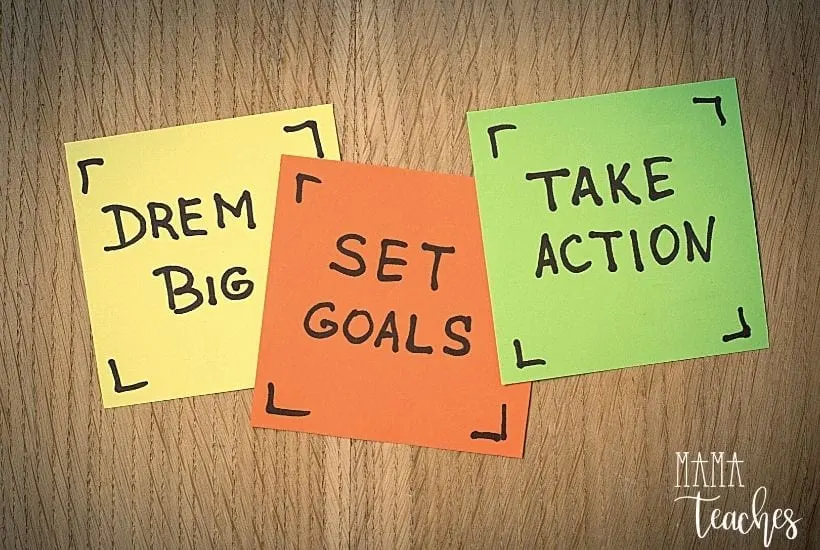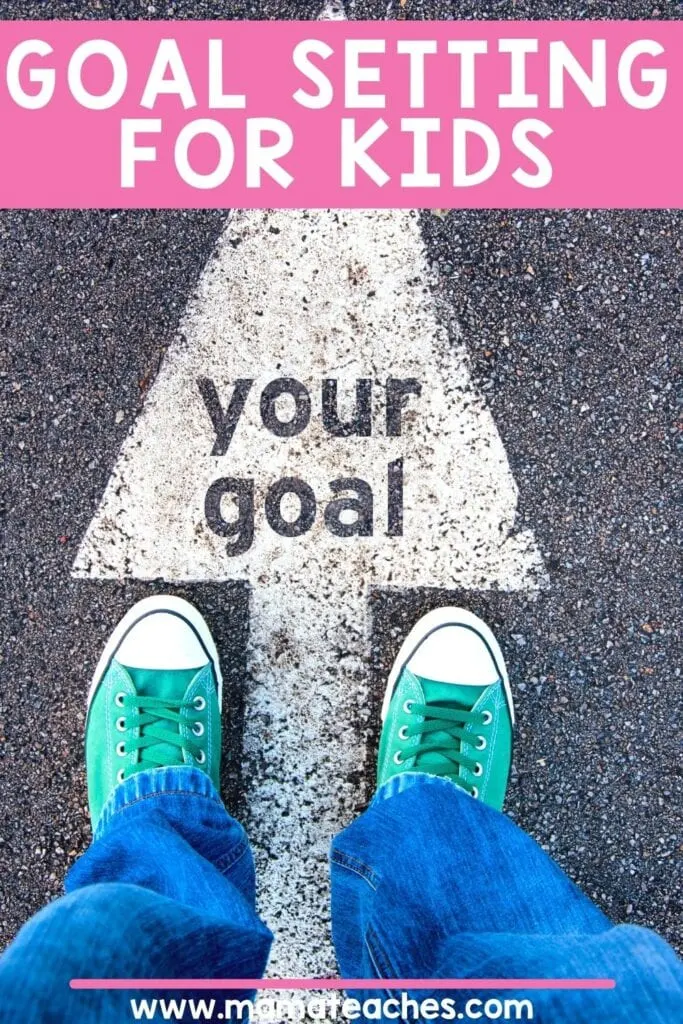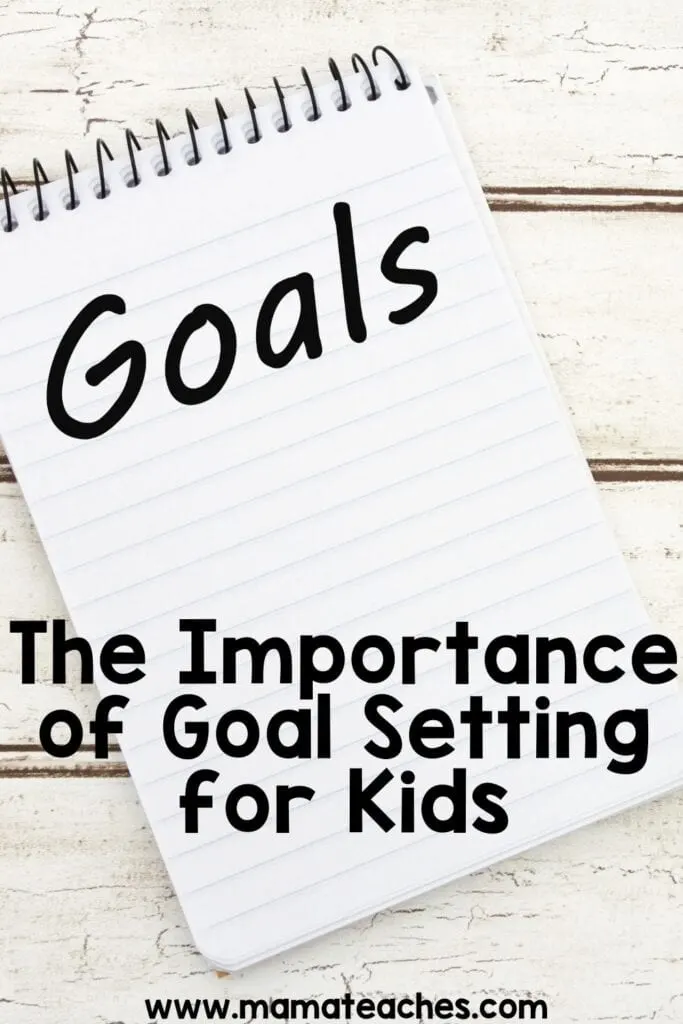Could setting a goal make your child motivated, determined, and self-confident?
Absolutely!
Goal setting for kids is a game-changer.
Goal Setting with Kids
Life is a journey, and your child needs to follow the trail blazes to help her on her way.
Goals act as those trail blazes.
They orient your child and keep her moving forward.
They also serve as a record of all she’s accomplished.
Goals are powerful motivators, and you should leverage their power to help your child progress–in large and small ways.

This article contains affiliate links to things that you might like.
Why Setting Goals Is Important
Andrew Carnegie once said, “If you want to be happy, set a goal that commands your thoughts, liberates your energy and inspires your hopes.” Basically, the right goals make you happy.
Goals can invigorate you.
No one wants to run a race of an unknown length (“Will this be a mile or a marathon?”).
If you have a goal, you have the energy and drive to work hard to meet it.
Goals also teach you determination.
Reaching a goal may require hard work, patience, and even sacrifice (if you are saving for a car, for example, you can’t spend all your money eating out).
When you reach a goal, you have the satisfaction that only comes from seeing the results of your labor.
It is a chance to celebrate how far you’ve come (and the work you’ve put in), giving you the confidence to reach for your future.
Different Types of Goals
When you are goal setting for kids, you need to consider different types of goals.
These goals may be personal or academic.
Goals don’t have to be large and overarching; small goals are important too.
Here are some examples of small, medium, and large goals.
Small Goals
- Tying shoelaces
- Learning to shake hands
- Writing your full name
- Memorizing your address and phone number
- Maintaining a consistent bedtime and/or waketime
- Reading 20 minutes a day
Medium Goals
- Preparing breakfast (or another meal) for yourself and/or others
- Riding a bike
- Keeping plants alive
- Earning the next martial arts belt
- Writing a letter once a week for a year
- Applying for college scholarships
Large goals
- Forming a positive friendship
- Learning to read
- Making a certain sports team
- Mastering an instrument
- Learning to speak a foreign language
- Consistently serving others through volunteerism
- Getting a summer job
- Studying consistently for the SAT
- Going to college

How to Set Goals
There are several goal-setting methods, but they should all have this in common.
They should follow the SMART rule: Specific, Measurable, Attainable, Realistic, and Timely.
Specific
When setting a goal for your child, be specific.
If the goal is too amorphous, it will be hard to determine the steps to get there (or even to know if you’ve achieved it).
You need to hone the goal for your child to make it more concrete.
Instead of saying, “I want you to do better in school,” your goal could be “I want you to raise your grades in each subject,” or “I want you to complete your homework before your watch TV or play videogames.”
Measurable
Make success something you can measure.
Instead of, “I want you to learn to ride a bike,” you say, “I want you to practice riding 5 days a week for 20 minutes at a time.”
Attainable
If you set goals that are not attainable, your child will feel defeated before he has begun.
Don’t set a goal for your child to stop wetting the bed at night–that is not something he can attain by simple will.
Don’t challenge a 3-year-old to read or a middle schooler to master the violin.
Realistic
This goes hand and hand with an attainable goal.
A realistic goal is one that a) the child can attain (and is developmentally appropriate) and that b) can be done in a reasonable amount of time.
Timely
A goal without a timeline is just a dream.
Set a schedule to work on the goal and a deadline to complete it.
Instead of, “I want you to be fluent in Spanish,” it should be, “I want you to practice your conversational Spanish three times a week for the next three months so you are ready for the trip to Costa Rica this spring.”

When to Have Kids Set Goals
You may set goals for your child, but he needs to learn to set goals for himself as well.
Transition from goal setting for kids to goal setting with kids.
Ask your child if he has anything he wants to accomplish in the next three months (for younger children) or the next six months to a year (for older children).
He may surprise you!
You will have to work with him to make the goal SMART (specific, measurable, attainable, realistic, and timely).
For younger children, make sure you write down the goal and keep a physical chart to mark her progress.
Middle schoolers and high schoolers may prefer to use a goal tracking app such as Strides or Way of Life.
By supporting your child in the goal-setting process, you show her you are her biggest cheerleader, counselor, and supporter.
Goal Setting for Kids
Help your child practice setting goals and working to achieve them.
This will set a pattern of determination and can-do spirit that will be hers for the rest of her life.
